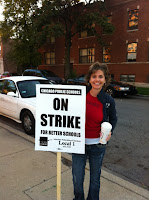CTU Strike the Week of September 10, 2012
image screen shot from ABC 7 news
This week Chicago Public School teachers went on strike for the first time in 25 years. I participated in the strike by joining my colleagues in front of our school to have our voices heard. I also participated in two of the organized rallies. The responses we saw in front of the school and on the viaduct over the Eisenhower Expressway were overwhelmingly positive. That being said there were also a few motorist who chose to express to us they were unhappy with the situation.
The strike is a great example to use to explain media literacy. I encountered radio ads that chose to focus on only the unkind aspects of the strike that were portrayed in the newspaper instead of both sides. The Mayor chose to use "repetition" in every speech he gave. He also left out some facts when referring to other Union agreements (remember no one tells us the whole story).
As I've stated to you on several occasions the goal of Media Literacy is to make you AWARE that ads send messages (both consciously and subconsciously). My hope is that if you encountered any of the examples I mentioned above that you began to QUESTION the text and subtext and to remember in the back of your mind that each author of advertisements has their own agenda.
I am proud to be a Chicago Public School teacher and member of the Chicago Teachers Union. I hope that when all is settled we can talk more about this campaign in technology lab.
Examples of Media Literacy during the CTU strike:
Radio Ad: While I couldn't find the actual audio file online this ad ran on several Chicago radio stations. It portrayed two Chicago Public School parents having a discussion about how disappointed they were with the teachers. The advertisement was paid for by the Democrats for Educational Reform and has business ties to the mayor. The parents speaking in the ad were not real CPS parents. They were paid actors.
Information about the advertisement:
http://www.catalyst-chicago.org/notebook/2012/06/05/20159/in-news-radio-ad-attacks-union-strike-vote
(screen shot from Catalyst article above)
An article in Friday September 21, 2012's Suntimes talks about how the advertisement mentioned above has been "bankrolled by union-bashers" (the subtitle of the article) and is estimated to have cost $1,000,000. It further goes on to talk about how the advertisement is unnecessary.
Additionally, Sunday's September 23, 2012's Suntimes contained an editorial telling the mayor that the advertisement isn't the way to mend relations with the union teachers. Its advises that this be the last the mayor talks about it on TV.
An additional resource about the Ad: http://www.catalyst-chicago.org/notebook/2012/09/25/20457/record-mayor-emanuels-ad
Example of Repetition: Mayor Emanual continued to call the strike a "Strike of Choice". Repetition is used in advertising to convince people to believe what the ad is saying is true. If people continue to hear or see something repeated some begin to say to themselves "this must be true since they keep bringing it up".
Additionally, Sunday's September 23, 2012's Suntimes contained an editorial telling the mayor that the advertisement isn't the way to mend relations with the union teachers. Its advises that this be the last the mayor talks about it on TV.
An additional resource about the Ad: http://www.catalyst-chicago.org/notebook/2012/09/25/20457/record-mayor-emanuels-ad
Example of Repetition: Mayor Emanual continued to call the strike a "Strike of Choice". Repetition is used in advertising to convince people to believe what the ad is saying is true. If people continue to hear or see something repeated some begin to say to themselves "this must be true since they keep bringing it up".
Newspaper Ad: We've learned that a basic concept in Media Literacy is that no one tells the whole story. The author determines what content they leave in or take out of their message. During the strike the Mayor referenced Boston Teacher's Contract essentially telling the public that Boston teachers were able to avoid a strike and they were fighting for the same things Chicago teachers were. Boston teachers took exception to that! They took out a FULL PAGE ad in the Chicago Sun-Times to tell the Mayor he was leaving out details (please note: this could be considered a "counter ad" which we will talk about in a few weeks).
Articles about the Boston Ad:
Social Media: Social Media was clearly a winner in the strike!! Teachers, parents, students, CPS, and everyday people not even involved in the dispute had something to say about it!! I personally had family debates over the strike on Facebook. Students from May School weighed in and some even joined us in the fight. The best part about it? Whether positive or negative the strike got people talking. It allowed everyone an equal voice and brought EDUCATION to the forefront.











Comments
Post a Comment